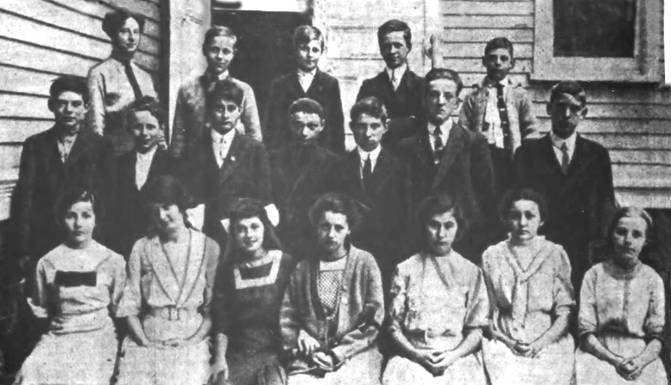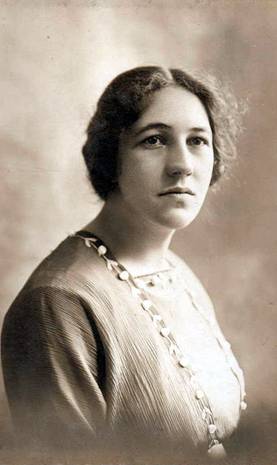Life at the Union School
Huntington Long-Islander, September 6, 1912
As can be seen in the above list, there was only one male in the faculty - the Principal. In this era, this pattern - multiple female worker bees and one King Bee - was not universal, but it was widespread. Even worse for career women, it was understood that female teachers had to remain single, so as to not disrupt schools by taking maternity absences.
The Union School actually consisted of two sections. The first was built in 1897; its similarly-sized neighbor to the west was built in 1909. Only two years after the school's size was doubled, it again was too small, due to the village's growth. For example, classes for the eighth, ninth, and tenth grade had to be held simultaneously in a single room, with their respective teachers covering different subjects.

One of Miss Farley's early Grade 8 classes at Nicholai Street Nassau
Daily Review-Star, May 9, 1941
The overcrowding grew worse every year. To gain classroom space, the School Board tried to eliminate Kindergarten, but the taxpayers rejected the idea. Ultimately, Kindergarten was moved off-site, although no truly suitable alternate location for it was ever found. Eventually, some senior grades used the "assembly hall" instead of class rooms; again, the space was unsuitable - and such use of an auditorium was contrary to State regulations. Second grade was put on split-sessions, using an innovative approach that reportedly had no negative impacts. The two teachers for the grade worked full days. In the morning session, one of them conducted the class at an accelerated pace, while in a back corner of the room a small group of "slower learners" got special attention from the other teacher. The afternoon session was similar, with the teachers' roles reversed. It was a trying time for everyone at the school. Mabel's position must have been exceptionally demanding, as at times she would have had to serve as a buffer for her boss.
Staff turnover was unacceptably high, with overcrowding a contributing cause. For example, in 1912-1913, there were twelve teachers on staff. As of March, only five of them were willing to commit to returning to their jobs in September, four were committed to leaving, and the remaining five might be rehired if they later were willing and available. The Principal, who would be the most difficult to replace if he left, likely was getting tired of dealing with both the School Board and with parents about problems, especially overcrowding. He was granted a three-week extension to decide, during which he probably tried very hard to find another job.

Huntington Long-Islander, March 7, 1913
Let's try to put the salary figures above into context. U.S. Census data indicates that at this time, the national average income for a male worker was about $680, and women averaged about half of that. In this context, the salaries listed above seem excellent - but in the New York metropolitan area, both salaries and costs were higher than the national average - a given income did not go as far in Hicksville as it would, say, in rural Kentucky. One indication that the teachers' salaries, while good, were not exceptionally high for the region is that many Hicksville teachers lived as boarders in homes or rooming houses. At first, for example, Mabel Farley boarded in the home of School Trustee Wetterau. Other teachers instead banded into small groups, and together shared a rented accommodation.
With regard to Farley's own educational aspirations, at the time, tuition for a full-time student at NYU was $150 a year. Prorating that figure downward for part-time students might still have left a figure that seemed substantial to a teacher whose annual income was $800 or less.
The 1915-1916 school year saw a development that probably will surprise many readers: Lera Farley, mentioned earlier as Mabel's younger sister, came to Hicksville as a teacher.

Lera Martha Farley
Devlin-Yard Family Tree, Ancestry.com

Huntington Long-Islander, September 3, 1915
Lera's name is mistakenly given as 'Vera'
Why did she come to Hicksville to teach? The Union School, as it often did in these years, may have had an unexpected late vacancy suitable for an experienced teacher. Or, as this was to be Lera's final year of teaching (i.e., she would marry in 1916; Mabel would serve as her Maid of Honor), the two sisters might have thought it would be nice to work together again. Or perhaps it was simply that the idea of spending some of her free time in New York appealed to Lera.
Alas, the overcrowding would continue far too long. It took more than a decade (and an intervention by the State of New York) before the people of Hicksville agreed to pay for the construction of adequate new classroom space. Until then, the faculty of the Union School - at least those among them who chose to stay at their jobs - had to improvise as best they could. Although Principals would change, Miss Farley would patiently remain the Assistant Principal for fourteen years.
***

